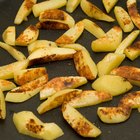
Jupiterimages/Stockbyte/Getty Images
Potatoes generally keep well for a couple of weeks, making them a handy standby, ready to throw in the oven and bake whenever you need a filling side dish or -- with some satisfying toppings -- a full meal. Store them improperly or for too long, though, and you might find that your potatoes have developed eyes and perhaps stems, sprouts and green spots. These are all signs of deterioration that indicate the potatoes are past their prime, but don’t throw them out just yet -- eyes don’t necessarily make potatoes inedible or unsuitable for baking.
Why Eyes?
Potatoes are a root vegetable, meaning the potato itself is a swollen root with the capacity to grow new roots as offshoots, even when it’s been picked and packaged for sale. An eye -- a small, round indentation that marks the skin of the potato -- is the base of a new root. Leave the potato long enough and the eye will sprout a stem; leave it even longer and the stem will develop into a long shoot with its own offshoots and leaves. Know that while these growths are toxic and should never be eaten, the potato itself remains safe to eat. Green spots on potatoes, which occur with extended exposure to sunlight, are also toxic and should not be eaten.
Eye Gouging
You can still bake and eat a potato that has eyes, but you should cut out the eyes before putting the potato in the oven. First, scrub the potato under running water, then dry it with a clean kitchen towel or paper towel. If the potato also has shoots, cut them away at the eye. Gouge out the eyes, as well as a small amount of the potato surrounding the eyes, using a sharp paring knife or the pointed end of a vegetable peeler, which is designed specifically for that purpose. Poke the point of the knife or peeler at an angle from the side of the eye to the mid-point underneath it, pivot the blade to encircle the eye, then scoop out a small conical piece of potato containing the eye. If the potato has green spots, slice them off with a knife.
Cook or Compost?
After you cut away any eyes, shoots and green spots, a potato is safe to eat. However, if it’s shrunken, soft to the touch or has wrinkled skin, the taste and texture of the potato will be unpleasant and it should be composted or thrown away. A firm potato with smooth skin and all bad parts cut away is safe for baking and eating, but could potentially make a disappointing baked potato. If you like baked potatoes mostly for their crispy skin, consider whether the post-op potato is worth baking -- if it’s covered in gouges and has slices of skin peeled away, perhaps the potato is destined for mashing, frying or another skinless application instead.
Potato Storage Tips
Prevent potatoes from developing eyes, shoots and green spots by storing them appropriately. Moisture and heat encourage starches in potatoes to turn into sugars and initiate the growth of new roots; exposure to sunlight causes green spots. Avoid these catalysts by keeping potatoes in a cool, dark, dry and well-ventilated spot. The best temperature for potato storage is between 40 and 50 degrees Fahrenheit, according to the Oregon Potato Commission. Don’t wash potatoes before you store them; just transfer them to a paper bag or perforated plastic bag. The longer potatoes are kept in storage, no matter how optimal the conditions, the more they will deteriorate, so only buy as many potatoes as you will eat within a week or two.
Related Articles

How to Tell When Baking Potatoes Are Bad

Why Do You Need to Pierce Potatoes ...

What Is the Best Potato for Frying?

Can You Eat Green Skins on Potatoes?

Can You Store Potatoes in the ...

Meals That Go Well With Baked Potatoes

How To Make Potato Chips With a Deep ...

List of Different Types of Potatoes

How to Boil Cubed Potatoes to Pan Fry ...
How to Boil Potatoes So They Can Be ...

How to Store Potatoes for the Long Term
Does a Baked Potato Cook Faster if You ...

Can You Over-Bake a Potato?

What Are Yellow Potatoes?

Do Potatoes Cook Faster if You Poke ...

How Long to Boil Potatoes Before Baking?

How to Sautee Potatoes

How to Cook Zuccini & Squash in a ...

How Long Do You Roast Potatoes & at ...

Can You Eat Peeled Potatoes After ...
References
Writer Bio
Joanne Thomas has worked as a writer and editor for print and online publications since 2004. Her writing specialties include relationships, entertainment and food, and she has penned pieces about subjects from social media tools for Adobe to artists’ biographies for StubHub. Thomas has also written for such names as Disney, Hyundai, Michelob and USA Today, among others. She resides in California and holds a bachelor’s degree in politics from the University of Bristol, U.K.
Photo Credits
Jupiterimages/Stockbyte/Getty Images